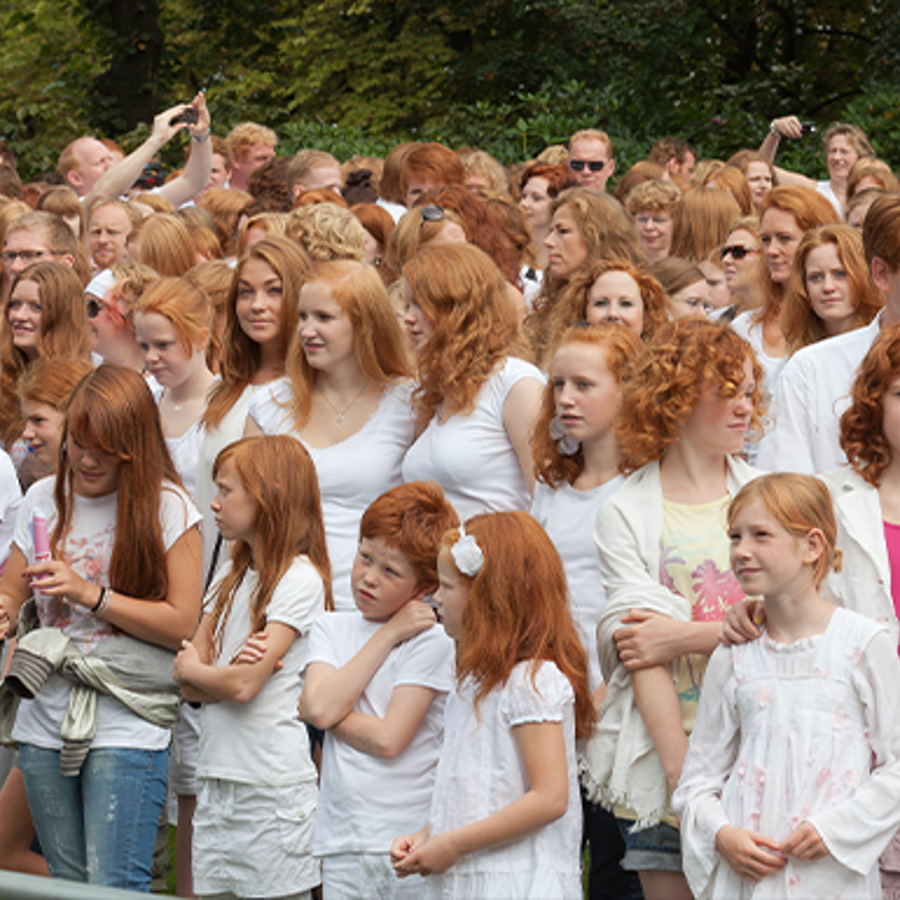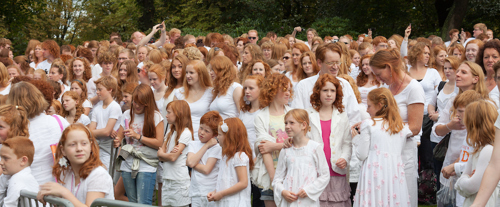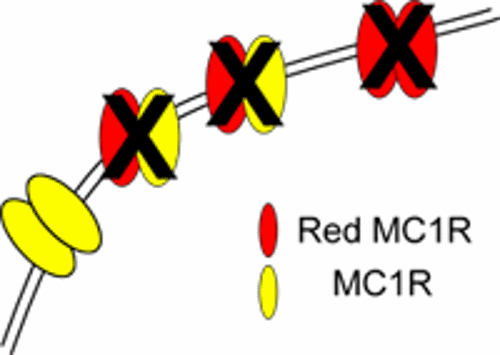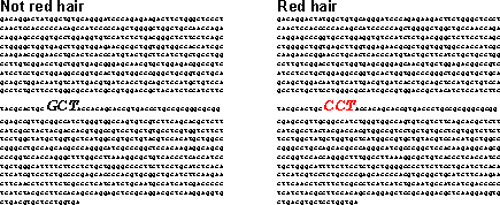
Is it possible to end up with red hair by getting the red hair gene from just one parent?
March 17, 2011

- Related Topics:
- Red hair,
- Hair color,
- Pigmentation traits,
- Complex traits,
- Genetic variation,
- Dominant and recessive
A curious adult from California asks:
"Is it possible to end up with red hair by getting the red hair gene from just one parent? If so, how common is it?"
Doesn't seem like it should be possible does it? As everyone who regularly reads our stuff knows, you need to get a red hair gene from both mom and dad to end up with red hair. Except, of course, when you don't.
Nothing in genetics is 100%; there are always exceptions. So there are redheads out there that got their red hair from one parent. And there are people who don't have red hair who got red hair from both parents.
And each of these is probably more common than most of us think. For example, in one recent study, scientists looked at 1092 people that had a single strong red hair gene. They found that 13 or 1.2% of them had red hair.
They also looked at people with two red hair genes. Out of 45 people with two copies of strong red hair genes, 10 didn't have red hair. This is a whopping 22% (although admittedly from a very small sample size).
These exceptions are most likely explained by which particular red hair gene someone has. And by the way that red hair gene interacts with all of their other 22,000 or so genes.
Before going any further, I want to be clear that there isn't really a red hair gene per se. Redheads don't have a special gene all of their own.
We all have the gene that is linked most strongly to red hair, MC1R. It is just that most red haired people have different versions of this gene compared to people without red hair.
An MC1R that is hitting on all cylinders keeps red hair away. So it makes sense that people with red hair usually have an MC1R gene that has a small difference in it that keeps it from working quite right. And there are lots of different versions of MC1R out there.
Some of these versions almost always lead to red hair. Others only lead to red hair sometimes. And some versions can lead to redheads that have darker skin and/or who can tan well.
Different versions of MC1R are not the only explanation for red hair that goes against the rules. Lots of different genes interact with MC1R or generally affect the amount and type of pigment our cells make. These kinds of genes can affect whether someone's MC1R gene ends up causing them to have red hair or not.
And please don't walk away thinking that MC1R is special. It isn't. Exceptions to genetic "rules" are much more common than you might think. We just know a lot more about this particular trait than we do many others.
For the rest of the answer, I want to focus on how strong red hair genes might cause red hair with just a single copy. Or how two strong ones might not be enough to cause red hair.

Genes Don't Work in a Vacuum
As I said before, red hair usually happens because of a glitch in both copies of your MC1R gene. But sometimes that glitch is strong enough to cause red hair in just one copy. And sometimes the red versions of this gene are in a genetic background that can overcome the red hair instructions in both copies.
The first case might seem really weird at first. How can a broken gene affect a working one? One way is by the broken version interfering with the working one.
Before going any further, another clarification. Like all other genes, the MC1R gene doesn't actually do anything by itself. The MC1R gene has the instructions for the MC1R protein. It is this protein that gets things done in the cell.
One of the MC1R protein's many jobs is to turn red pigment (pheomelanin) into brown pigment (eumelanin). The most common way that red hair happens is when the MC1R protein can't do this causing red pigment to build up.
So our cells read the MC1R gene and translate the instructions into the MC1R protein. Eventually two copies of the protein end up stuck together in the cell membrane. There they can, among other things, busily orchestrate the conversion of red pigment into brown.
One of the ways a single copy of a red MC1R gene can cause red hair is by keeping the fully functioning copy from working. Basically a red MC1R protein sticks to a not-red protein and keeps the not-red one from doing its job. This is called a "dominant negative" mutation.

This might be part of the explanation for the R160W version. This copy of MC1R has been shown to get in the way of the not-red or working copy. And in that study I talked about earlier, 7 out of 178 (or 4%) people with one copy of R160W had red hair. This is higher than the 1.2% seen with all strong red hair genes.
Of course, 171 of these folks didn't have red hair. And neither did lots of other people who had the other dominant negative red hair genes. So having a dominant negative version may just contribute to ending up with red hair with a single red MC1R. Other genes probably need to help out too.
MC1R does not work in a vacuum. Lots of genes can affect how well the MC1R protein can do its job. Others can affect both the amount and type of pigment that gets made. And both can affect MC1R.
Imagine we have someone with a fully functioning copy of MC1R and an R160W copy. Because R160W is dominant negative, this person actually has less than a fully working copy. Think of this person as essentially having half a working copy.
Now imagine this person has a difference in another gene that affects how much red pigment gets made. This person makes enough red pigment that the bit of MC1R that works gets swamped. It can't handle all the red pigment and so the person ends up with red hair.

Another possibility is a gene like ASIP. Genes like this one directly affect how MC1R does its job. (In fact, some people have red hair with two not-red versions of MC1R because of the ASIP version they have.)
Imagine our R160W person has an ASIP gene that makes a protein that can't work as well with MC1R. Now the bit of MC1R that is left is too feeble to turn red pigment into brown. Again we have a redhead who has just one red version of MC1R.
There are lots of other scenarios we can spin as well to explain how these things can happen. All because genes affect how other genes work and because not all DNA differences that lead to red hair are created equally.
As I said earlier, it is also possible for people to have two strong red hair genes and not to have red hair. The main reason for this is that these genes aren't usually totally dead. They are merely wounded.
So most people with two red versions of MC1R have a bit of MC1R activity left. Perhaps they make so little red pigment that their residual MC1R activity can handle it. Or they have versions of ASIP that can supercharge their bit of MC1R activity. Or maybe they have another gene that can help MC1R out.
Genes are a messy business. The neat and tidy rules we learn in high school and college explain a lot of what is going on but not everything. This is one of the reasons studying genes is so cool.
Read More:

Author: Dr. D. Barry Starr
Barry served as The Tech Geneticist from 2002-2018. He founded Ask-a-Geneticist, answered thousands of questions submitted by people from all around the world, and oversaw and edited all articles published during his tenure. AAG is part of the Stanford at The Tech program, which brings Stanford scientists to The Tech to answer questions for this site, as well as to run science activities with visitors at The Tech Interactive in downtown San Jose.
 Skip Navigation
Skip Navigation
